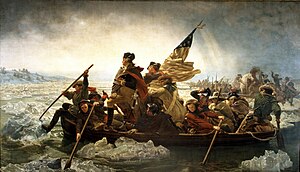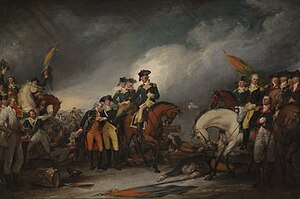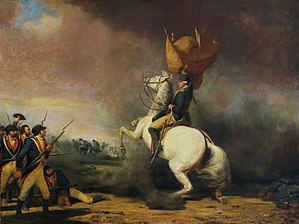American Revolution/The Battles of Trenton and Princeton
Battle of Trenton
[edit | edit source]Prior to Christmas, moral of the Continental Army was at an all time low. Most soldiers contracts would be up by the end of the year, and it seemed that the Revolution was lost. Washington knew he needed a quick victory in order to inspire new recruits and get old ones to stay. He decided that they would attack the British at Trenton.
The American Plan
[edit | edit source]The American plan relied on launching coordinated attacks from three different directions. General John Cadwalder would launch a diversionary attack against the British garrison at Bordentown, in order to block off any reinforcements. General James Ewing would take 700 militia across the river at Trenton Ferry, seize the bridge over the Assunpink Creek and prevent any enemy troops from escaping. The main assault force of 2,400 men would cross the river nine miles north of Trenton, and then split into two groups, one under Greene and one under Sullivan, in order to launch a pre-dawn attack. Depending on the success of the operation, the Americans might possibly follow up with separate attacks on Princeton and New Brunswick.
During the week prior to Christmas, American advance parties had begun to ambush enemy cavalry patrols, capturing dispatch riders, and attacking Hessian pickets. This became so effective, that the Hessian commander had to send 100 infantry and an artillery detachment to protect his letter to the British commander at Princeton.
Hessian Moves
[edit | edit source]Trenton had two main streets, King (now Warren) Street and Queen (now Broad) Street. Rall had been ordered to build a redoubt at the head of these two streets (where the battle monument stands today) by his superior, Count Carl von Donop, whose own brigade was stationed in Bordentown. Donop himself had marched south to Mount Holly on December 22 to deal with the South Jersey Rising, and clashed with the New Jersey militia there on December 23.
Rall was a 36-year professional soldier with a great deal of battle experience who had requested reinforcements and been turned down by British commander General James Grant. Grant regarded the Americans with great disdain and sent no reinforcements. Rall's subordinates were convinced that the Americans were going to attack, but Rall himself was not worried, he believed that one bayonet charge would send the Americans fleeing with panic, as bayonet charges had done before.
The Crossing
[edit | edit source]
Before Washington and his troops left, Benjamin Rush had come in an attempt to cheer up the General. While he was there he saw a note Washington had written which said "Victory or Death". Those words would be the watchword for the surprise attack. The terrible weather conditions delayed the landing in New Jersey, which were supposed to be completed by 12:00 am until 3:00 am, and Washington realized it would be impossible to launch a pre-dawn attack. Another setback also occurred for the Americans. Both General Cadwalder and Ewing were unable to join in the attack due to the weather conditions.
For the next four and a half hours, the American troops marched to Trenton. It was a miserable trip. Many did not have boots, so they were forced to wear rags around their feet. Many men's feet bled, turning the snow to a dark red. Two men even laid down in the snow, only never to get back up.
The Battle
[edit | edit source]A small guard post was set up by the Hessians in Pennington about nine miles (14 km) north of Trenton, east of Washington's route to the city. When the squad guarding this post saw the large American force on the march, Lieutenant von Wiederholdt, in command of this Pennington picket, made an organized retreat. Once in Trenton the picket began to receive support from other Hessian guard companies on the outskirts of the town. Another guard company nearer to the Delaware River rushed east to their aid, leaving open the River Road into Trenton. General John Sullivan, leading the southern American column entered Trenton by this route and made hard for the only crossing over the Assunpink Creek, which was the only way out of Trenton to the south, in hopes of cutting off the Hessian escape.

When the 35 Hessian Jägers under the command of Lieutenant Grothausen who were stationed at the barracks on the northern edge of the town saw the vanguard of Sullivan's forces charging into Trenton, they ran over the Assunpink bridge and left Trenton. Slowly, various companies of the three defending regiments formed and entered the battle. Lieutenant Biel, Rall's brigade adjutant, finally awoke his commander, who found that the rebels had taken the "V" of the major streets of the town where earlier that month Pauli would have constructed the redoubt. The northern American column quickly took this position. The Americans stationed two cannon on a rise that guarded the two main routes out of the town. The Hessians tried to bring four guns into action, but American fire kept them silent, and denied the Hessians a chance to form in the streets. The remaining men in the column, along with the other American column near the river, moved to surround the Hessians.
The Knyphausen regiment of Hessians was separated from the other two regiments and driven back through the southern end of Trenton by John Sullivan's column. The other two Hessian regiments, Lossberg and Rall, retreated into an open field and attempted a counterattack that was quickly driven back. Rall ordered his force to retreat southeast into an apple orchard just outside Trenton. The Hessians in the orchard attempted to reorganize, and make one last attempt to retake the town so they could escape to Princeton.
The Americans, by this time, occupied the majority of the buildings and, from cover, fired into the ranks of the Rall regiment as the Hessians advanced. As the Hessians fought back into the streets of Trenton, they came under fire from cannons, and even some civilians who had joined the battle. Their formations were broken up by cannon fire. At this point, Rall was mortally wounded. The Hessians then retreated back to the Orchard, where they were then surrounded and forced to surrender.
The remains of the Knyphausen Regiment were attempting to escape to Bordentown, but they were slowed when they tried to haul their cannon through boggy ground. They were cut off from the bridge, surrounded by Sullivan's men, and forced to surrender. The regiment surrendered just minutes before the rest of the brigade.
Casualties and Effects
[edit | edit source]The American forces had suffered only a handful of wounded, although two men died of hypothermia on the march and more the next night, while the Hessians suffered 115 casualties with at least 25 dead, as well as 920 captured. The captured Hessians were sent to Philadelphia, and later Lancaster only to be moved once again in 1777, this time to Virginia.

Rall was mortally wounded and died later that day at his headquarters. All four Hessian colonels in Trenton were killed in the battle. The Lossberg regiment was effectively removed from the British forces. Parts of the Knyphausen regiment escaped to the south, but Sullivan captured some 200 men along with the regiment's cannons and supplies. Also captured were about 1,000 arms and some much-needed ammunition.
Only four Americans were wounded, two during the rush to capture Hessian artillery before they could be used in the battle. These wounded were officers: Captain William Washington (the general's cousin), who was badly wounded in both hands, and young Lieutenant James Monroe, the future President of the United States. Monroe was carried from the field bleeding badly after he was struck in the left shoulder by a musket ball, which severed an artery. Doctor John Riker clamped the artery, keeping him from bleeding to death.
Battle of the Assunpink Creek
[edit | edit source]Lieutenant General Charles Cornwallis had left 1,400 British troops under the command of Lieutenant Colonel Charles Mawhood in Princeton, New Jersey. Following the victory at the Battle of Trenton early in the morning of December 26, 1776, General George Washington of the Continental Army and his council of war expected a strong British counter-attack. Washington and his council decided to meet this attack in Trenton.
The Battle
[edit | edit source]On December 30, he crossed the Delaware River back into New Jersey and, over the next few days, massed his troops on higher ground south of Trenton, across a stream running through downtown called Assunpink Creek. On January 2, 1777, the day-long march ended when the larger British army led by General Cornwallis encountered Washington's own army. The Americans slowly withdrew, splitting into smaller units in order to harrass the British. The small groups of American soldiers had succeeded in slowing Cornwallis' march from Princeton to Trenton, and inflicting heavy casualties, but the British force arrived en masse in the late afternoon.
The armies were facing each other from 200 yards (200 m) apart with only the creek and the bridge in between. Cornwallis ordered the assault. Cannon and rifle fire erupted from Washington's side leaving heavy British casualties after fierce fighting. Two more attempts were made by the British to take the bridge, but each time they were repulsed. The bridge held, darkness fell, and Cornwallis withdrew. Hundreds of British soldiers were recovered from the bridge ending the battle. Cornwallis commented "Rest for now. We'll bag the fox in the morning."
Escape
[edit | edit source]That night, Washington's army built up their campfires before silently slipping away after midnight while an unsuspecting Cornwallis slept. Cornwallis had failed to post adequate scouts to detect movements by Washington's army. Washington and his staff decided to sneak away in the night, marching around the British forces and attacking their rear in Princeton. The Americans left a token force to build fortifications as though they were planning to defend at the creek and to disguise the sound of their march. British forces perceived the movement, but Cornwallis believed this to be Americans planning a night attack and ordered British troops into defensive positions, allowing Americans to successfully march their army around Cornwallis
Battle of Princeton
[edit | edit source]Throughout the night, the army marched over a back road toward Princeton and reached the Quaker Bridge over Stony Brook, about a mile south of town. The Quaker Bridge was not strong enough to support the army’s cannon and ammunition carts, so another bridge had to be built quickly. While the bridge was being constructed, Washington reformed his army, and then split it into two parts—the smaller left wing under General Nathanael Greene and the larger right wing under General John Sullivan. Washington had intended to attack Princeton before dawn, but the sun was rising.
Greene’s assignment was to advance to the Princeton-Trenton highway to stop its traffic and destroy its bridge over Stony Brook. Sullivan’s division, the main attack force, moved toward the rear of the College of New Jersey (now Princeton University). The British were known to have outposts on the roads to the north, east and west, but an abandoned road went into town from the west, which Sullivan took.
Before Greene’s wing (with 3,400 men) reached the highway, the leading brigade, 1,200 men under General Hugh Mercer of Virginia, encountered 800 men who were elements of the British 4th Brigade, accompanied by 2 light guns, under the overall command of Lieutenant Colonel Charles Mawhood. The British group was marching from Princeton to Trenton to reinforce General Leslie's 2nd Brigade. The last unit of the 4th Brigade was left to hold Princeton with another 400 men.
The Battle
[edit | edit source]Upon seeing the American force, Mawhood formed up his men across the edge of an orchard which Mercer's troops were passing through. A violent firefight developed, and Mawhood launched an assault which largely cleared the orchard of Mercer's troops, who began to retreat in confusion. General Mercer was wounded but refused to surrender. When he tried to attack the enemy with his sword, he was bayoneted until presumed dead; he died nine days later. Colonel John Haslet of Delaware replaced General Mercer and was killed by a shot to the head.
During this confusion, General Washington rode up to rally Mercer's men, while a fresh brigade of 2,100 troops under General John Cadwalader arrived with an artillery battery. Washington then rode straight into the British fire, personally leading the attack. As Washington charged towards the British lines, he was heard yelling "Parade with me my brave fellows, we will have them soon!"
With these reinforcements, and Washington having successfully rallied Mercer's men, the larger American force was able, by pressure of numbers, to retake most of the orchard, until fire from Mawhood's guns halted the American advance.

A second British assault cleared the orchard, and seemed about to win the day until Sullivan led up another 1,300 troops. Now outnumbered nearly 6 to 1, Mawhood led a final charge to break through American lines. A number of the British soldiers broke through the Americans in a desperate bayonet charge, continuing down the road to Trenton. Washington led some of his force in pursuit of Mawhood, but they abandoned this and turned back when some of Leslie's troops came into sight. The remainder of the British fell back into Princeton, which, along with the men already there, they defended against Sullivan's force for a while, before retreating to New Brunswick. A number of troops were left behind in Princeton. Facing overwhelming numbers and artillery fire, they surrendered. The British casualty list stated 86 killed and wounded and 200 captured. The Americans suffered 40 killed and wounded.
In Trenton, Cornwallis and his men awoke to the sounds of cannon fire coming from behind their position. Cornwallis and his army began to race to Princeton. However, Washington's rear guard had managed to damage the bridge over the Stony Brook, and American snipers further delayed Cornwallis' Army. The exhausted American Army slipped away, marching to Somerset County Courthouse (now Millstone), where they spent the night. When the main British force finally reached Princeton late in the day, they did not remain but continued in haste toward New Brunswick, New Jersey.
Aftermath
[edit | edit source]After the battle, Cornwallis abandoned many of his posts in New Jersey, and ordered his army to retreat to New Brunswick. The battle at Princeton cost the British some 100 men killed, 70 wounded 280 captured and greatly boosted the morale of the Continental troops, leading 8,000 new recruits to join the Continental Army.
American historians often consider it a great victory on par with the battle of Trenton, due to the subsequent loss of control of most of New Jersey by the Crown forces as well as the important political implications of the battle across the Atlantic in France and Spain, both of which would expand their military aid to the Continental forces after the battle. Fredrick the Great is to have pronounced Washington's achievements in those few weeks, the most brilliant in military history.